An intriguing exploration into the unique relationship between bees and honeysuckle, uncovering surprising ecological insights.

Do Bees Like Honeysuckle?
Dive into the buzzing world of bees, where the love for honeysuckle isn't as straightforward as it seems. You've likely seen these industrious insects buzzing about your garden, drawn to the fragrant, nectar-rich blooms.
Yet, have you ever wondered if bees have a particular affinity for honeysuckle? This question isn't just about casual curiosity, but touches on significant ecological aspects, including pollination patterns and plant-insect relationships.
The answer may surprise you, but let's not spill all the honey just yet. Stick around, and together we'll explore this fascinating aspect of nature.
Key Takeaways
- Bees are attracted to honeysuckle due to its rich nectar content and vibrant colors.
- Honeysuckle's tubular flowers are ideally suited for bees, allowing easy access to nectar.
- Honeysuckle's vibrant colors and intoxicating scent are evolutionary adaptations to attract bees.
- Bees pollinating honeysuckle contribute to biodiversity, ecosystem support, natural balance, and habitat creation.
Understanding Bees' Floral Preferences
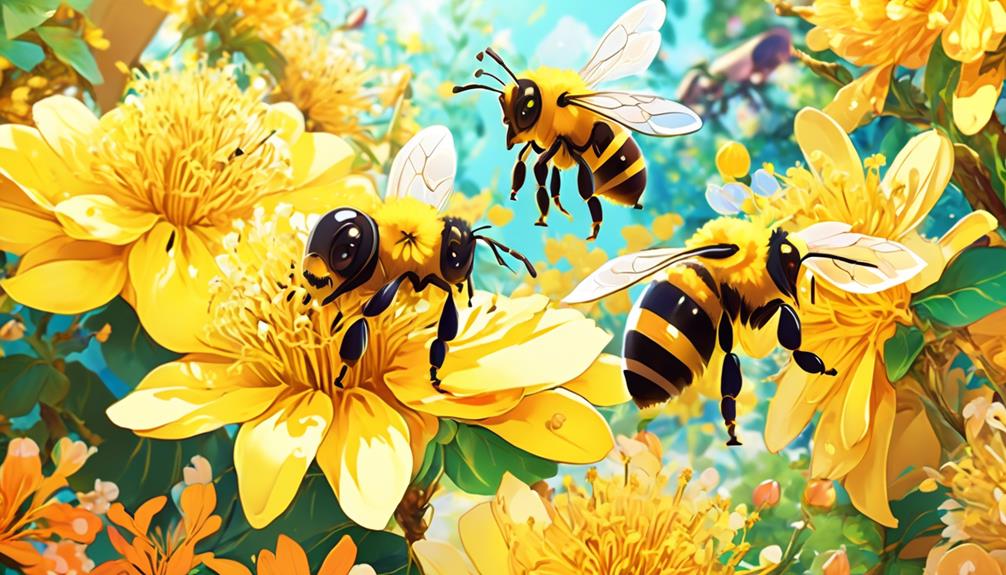
Delving into the world of bees' floral preferences, it's crucial to note that these industrious insects are particularly drawn to honeysuckle due to its rich nectar content and vibrant color. It's not just about aesthetics; the physiological factors at play are far more intricate.
Honeysuckle's bright color spectrum, particularly its yellows and oranges, acts as an attracting beacon for bees. These colors are within the bees' visual range and they perceive them as a signal of abundant nectar. They've evolved to recognize these hues as an indication of a rewarding food source.
The nectar of the honeysuckle, laden with sugars, provides the energy bees need for their high metabolic rates and industrious lifestyles. But it's not just about energy, the nectar's complex mixture of sugars, amino acids, and other compounds also contribute to the health and longevity of the bee colony.
Furthermore, the physical structure of the honeysuckle flower, with its tubular form, is ideally suited for bees. The flower's shape provides easy access to the nectar while simultaneously facilitating pollen transfer. This mutual benefit is the result of a long-standing co-evolutionary relationship between bees and honeysuckle.
Honeysuckle: A Brief Overview
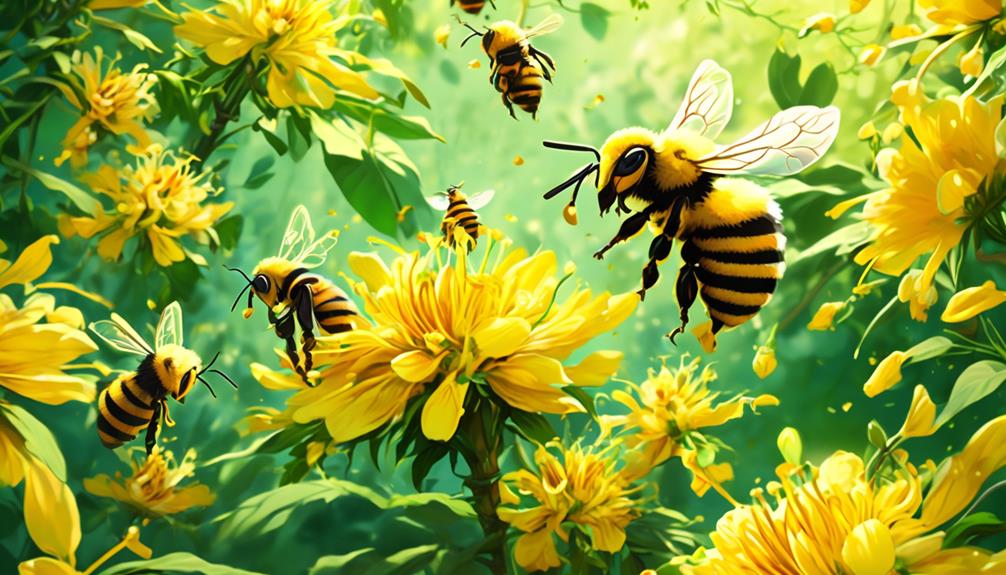
Now, let's turn our attention to the honeysuckle itself, a plant as fascinating as the bees it attracts.
Honeysuckle, scientifically known as Lonicera, belongs to the Caprifoliaceae family. This plant family comprises about 180 species of ornamental shrubs and climbers, distributed nearly worldwide.
You'll find these plants in various forms, from twining vines to shrubs and they're predominantly deciduous, though some are evergreen. The leaves are generally simple and opposite, presenting variations in shape and size across species.
The flowers, a real show-stealer, are tubular in shape with a sweet, intoxicating fragrance that lures in pollinators, including bees. They come in an array of colors, from white to yellow, pink, and red, depending on the species.
The honeysuckle's nectar, rich in sucrose, is a major draw for bees. This plant's unique structure, called a nectary, allows bees easy access to its sugary reward.
Bees play a vital role in the pollination of the honeysuckle, transferring pollen from the male anthers to the female stigma, thereby aiding in the plant's reproduction. This symbiotic relationship between bees and honeysuckle is a fascinating spectacle of nature's efficiency.
The Science Behind Bees and Honeysuckle
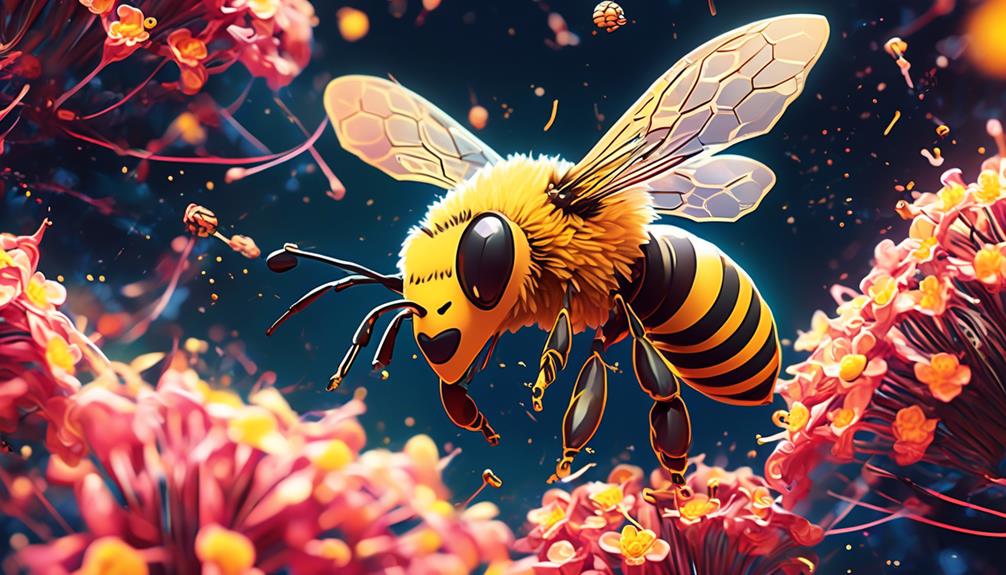
To truly understand the intricate relationship between bees and honeysuckle, it's essential to delve into the scientific aspects that underpin this symbiosis. This relationship is driven by mutual benefits: bees relish the honeysuckle's sweet nectar, while the plant depends on bees for pollination.
The science behind this interaction starts with the honeysuckle's structure. Its tubular flowers are ideally suited for bees, specifically the long-tongued species. These bees can easily reach the nectar, housed at the tube's base, with their extended proboscis. As they feed, pollen from the stamen sticks to their bodies, ready for transfer to the next flower.
Moreover, the honeysuckle's vibrant colors and intoxicating scent are irresistible to bees. These features aren't random but are evolutionary adaptations to attract pollinators. Bees see in the ultraviolet spectrum, so the plant's colors are especially striking to them. The scent serves as an additional attractant, guiding bees to the nectar source.
Lastly, honeysuckle's peak blooming period is at dusk and dawn, coinciding with bees' foraging times. This synchronization ensures that bees have a reliable food source and the plant gets pollinated. Thus, the relationship between bees and honeysuckle is a fascinating study of nature's interconnectedness, efficiency and mutual support.
Ecological Benefits of Bees Pollinating Honeysuckle
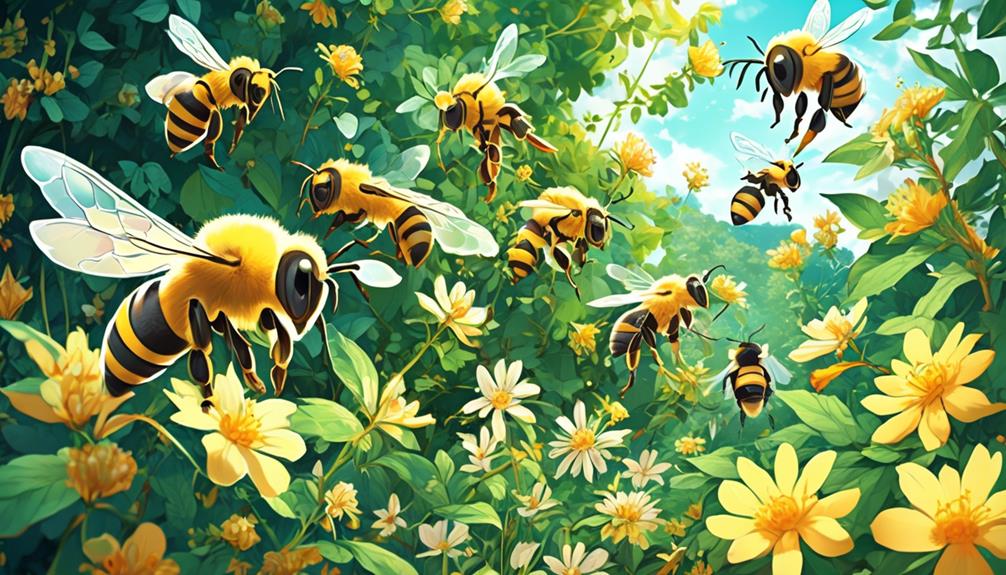
When bees pollinate honeysuckle, they're not just satisfying their hunger and ensuring the plant's reproduction, but they're also contributing significantly to the broader ecological balance. Each visit to a honeysuckle bloom initiates a chain of ecological events, boosting biodiversity and sustaining ecosystems.
Ecological Impact | Explanation |
|---|---|
Biodiversity Boost | As bees transfer pollen, they facilitate cross-pollination, encouraging genetic diversity among plants. |
Ecosystem Support | Many animals, birds, and insects rely on honeysuckle berries for food. Bees' pollination ensures this food source. |
Natural Balance | Bees help to maintain a natural balance and control pests by pollinating plants that serve as habitats for beneficial insects. |
Habitat Creation | Honeysuckle plants, once pollinated and matured produce dense thickets providing shelter for various wildlife. |
Encouraging Bees Into Your Garden With Honeysuckle
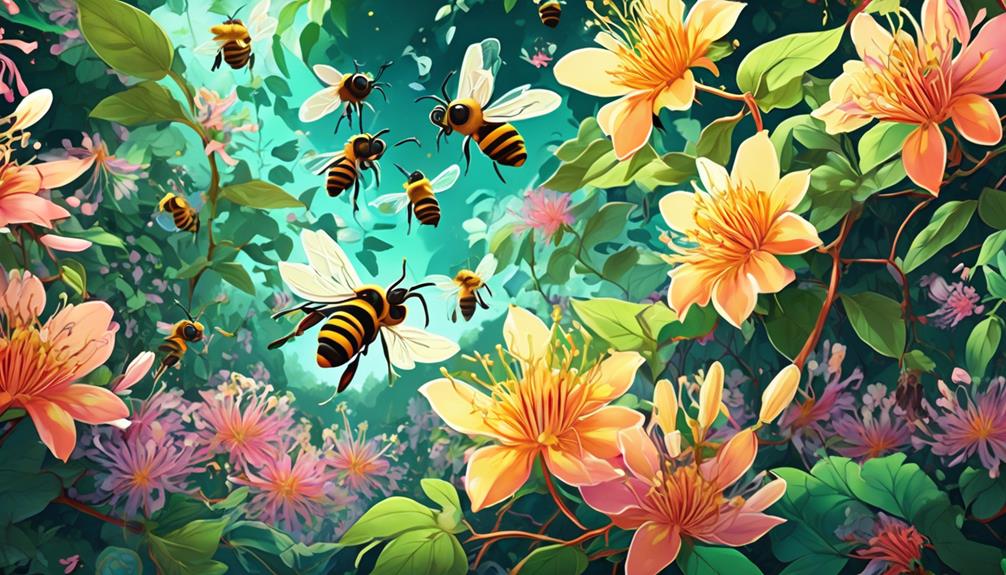
Understanding the ecological importance of bees pollinating honeysuckle, you might be wondering how you can attract these beneficial insects to your own garden using this fragrant and nectar-rich plant. It's simpler than you might think.
To begin, select a suitable honeysuckle variety, considering factors like your climate, soil type, and sunlight exposure. Lonicera periclymenum and Lonicera japonica are both prolific nectar producers and therefore, prime choices.
Next, honeysuckle should be planted in a sunny, well-drained area of your garden. Bees are more attracted to plants in sunny locations as sunlight increases nectar production. It's also important to water your honeysuckle regularly, particularly in dry periods, to ensure it continues to produce nectar.
Bear in mind that bees are highly sensitive to pesticides, so avoid using harmful chemicals in your garden. Instead, opt for organic pest management strategies.
Lastly, remember that diversity attracts bees. Incorporate other nectar and pollen-rich plants, like salvia and lavender, to create a diverse buffet for bees. This not only boosts your garden's appeal, but also contributes to the overall health and resilience of your local bee populations.
Frequently Asked Questions
What Types of Honeysuckle Are Most Attractive to Bees?
You're likely to see bees buzzing around Japanese Honeysuckle and Coral Honeysuckle the most. They're attracted to the sweet nectar these varieties produce. Additionally, the trumpet shape of the flowers on these honeysuckle plants provides an ideal landing platform for bees.
But remember, it's not just about the type of honeysuckle. Bees are also drawn to plants that are healthy and well-taken care of, so keep that green thumb in action!
Are There Specific Times of Day When Bees Are More Likely to Visit Honeysuckle Flowers?
Yes, there are specific times when bees are more likely to visit honeysuckle flowers.
Bees are typically most active during the warmest parts of the day, usually between mid-morning and mid-afternoon.
They're also more attracted to honeysuckle when it's in full bloom, which can depend on the specific variety and growing conditions.
However, remember that many factors can influence a bee's behavior, including weather and availability of other food sources.
How Does the Honeysuckle's Nectar Affect a Bee's Health?
Honeysuckle's nectar can have a positive impact on a bee's health. It's rich in sugars, providing energy, and contains essential amino acids, aiding in growth and development.
However, it's not just about nutrition. The nectar's aroma attracts bees, promoting pollination.
Do Bees Have a Preference for Honeysuckle Over Other Types of Flowers?
Yes, bees do have a preference for honeysuckle over other types of flowers. They're drawn to its sweet, fragrant nectar and its tubular shape, which is perfect for their long tongues. You'll often see bees buzzing around honeysuckle, busily collecting nectar.
However, this doesn't mean they won't visit other flowers. Bees are opportunistic and will go where the nectar is, but honeysuckle is definitely a favorite.
Can the Presence of Honeysuckle in a Garden Increase the Overall Bee Population in the Area?
Yes, having honeysuckle in your garden can boost the local bee population. Bees are attracted to the sweet nectar of honeysuckle flowers. As they move from flower to flower, they're spreading pollen, which aids in the creation of more flowers.
Therefore, a garden rich in honeysuckle could become a hotspot for bees, potentially increasing their numbers in your area. But remember, a variety of plants will attract a wider range of pollinators.
Conclusion
In summation, bees do love honeysuckle. The sweet nectar and vibrant colors attract these pollinators, aiding in both their survival and the propagation of honeysuckle.
Encouraging this relationship in your garden not only adds beauty but also promotes a healthier ecosystem. So, go ahead, plant some honeysuckle.
You'll be aiding our buzzing friends, contributing to the biodiversity of your local area, and creating a visually appealing garden space. It's a win-win situation!



